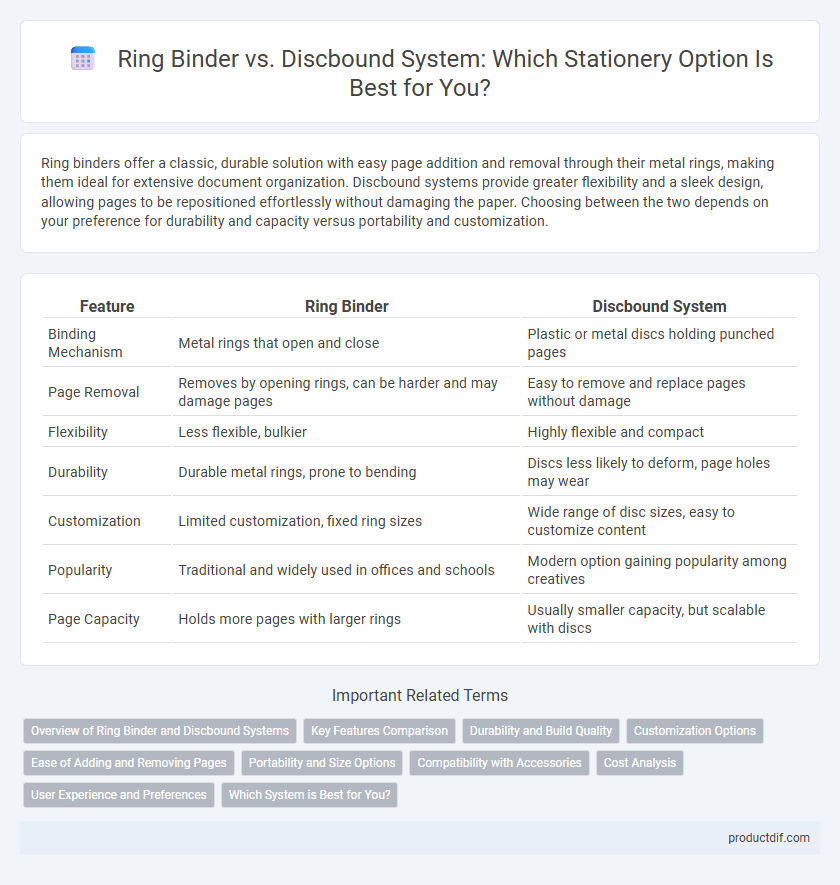Ring binders offer a classic, durable solution with easy page addition and removal through their metal rings, making them ideal for extensive document organization. Discbound systems provide greater flexibility and a sleek design, allowing pages to be repositioned effortlessly without damaging the paper. Choosing between the two depends on your preference for durability and capacity versus portability and customization.
Table of Comparison
| Feature | Ring Binder | Discbound System |
|---|---|---|
| Binding Mechanism | Metal rings that open and close | Plastic or metal discs holding punched pages |
| Page Removal | Removes by opening rings, can be harder and may damage pages | Easy to remove and replace pages without damage |
| Flexibility | Less flexible, bulkier | Highly flexible and compact |
| Durability | Durable metal rings, prone to bending | Discs less likely to deform, page holes may wear |
| Customization | Limited customization, fixed ring sizes | Wide range of disc sizes, easy to customize content |
| Popularity | Traditional and widely used in offices and schools | Modern option gaining popularity among creatives |
| Page Capacity | Holds more pages with larger rings | Usually smaller capacity, but scalable with discs |
Overview of Ring Binder and Discbound Systems
Ring binders use metal rings to hold punched paper, providing easy page addition and removal with a sturdy, traditional design. Discbound systems rely on circular discs and specially punched pages, offering greater flexibility and the ability to rearrange pages without opening rings. Both systems cater to organization and customization, with ring binders better suited for heavy-duty use and discbound systems favored for portability and modularity.
Key Features Comparison
Ring binders offer fixed, durable metal rings typically ranging from 2 to 3 inches in diameter, allowing easy insertion and removal of standard punched paper with reliable page protection. Discbound systems utilize flexible discs that enable effortless page turning and modular customization by snapping pages in and out without damaging holes, ideal for personalized planners or notebooks. While ring binders support widespread document compatibility, discbound systems excel in portability and reorganization efficiency.
Durability and Build Quality
Ring binders typically feature robust metal rings and reinforced covers, offering excellent durability for frequent use and heavy document storage. Discbound systems use flexible discs that provide moderate durability but may wear over time with extensive page turning. High-quality ring binders often surpass discbound systems in build quality, making them ideal for long-term organization and archival purposes.
Customization Options
Ring binders offer extensive customization options through interchangeable dividers, sheet protectors, and refillable pages, allowing users to organize documents efficiently. Discbound systems provide enhanced flexibility with pages that can be easily added, removed, or repositioned without damaging the paper, ideal for dynamic note-taking and planning. Both systems support personalized inserts and covers, but discbound systems excel in modularity and adaptability for evolving content needs.
Ease of Adding and Removing Pages
Ring binders offer straightforward insertion and removal of pages through their metal rings, but frequent opening can weaken the holes over time. Discbound systems utilize discs that allow pages to snap in and out easily, providing a flexible and durable way to reorganize without damaging the paper. The discbound design enhances efficiency for users who regularly customize their notebooks or planners.
Portability and Size Options
Ring binders typically offer limited portability due to their bulkier design and fixed size options, often ranging from 1 to 3 inches in ring diameter. Discbound systems provide enhanced portability with compact, customizable sizes that allow users to easily add or remove pages without damaging them, fitting comfortably into smaller bags or cases. The modular nature of discbound notebooks makes them highly versatile for on-the-go use, catering to various organizational needs.
Compatibility with Accessories
Ring binders offer broad compatibility with standard hole-punched accessories such as dividers and sheet protectors, making them ideal for traditional office use. Discbound systems require accessories designed specifically for their proprietary disc punch, limiting options but allowing for easy customization and rearrangement. Users must consider their accessory preferences and availability when choosing between the two systems.
Cost Analysis
Ring binders generally offer a lower upfront cost compared to discbound systems, making them a budget-friendly choice for organizing documents. Replacement rings and covers for binders are widely available and affordable, while discbound accessories tend to be pricier due to specialized materials. Over time, discbound notebooks may save costs by allowing easy page removal and rearrangement without damaging the binding, but initial investment remains higher than traditional ring binders.
User Experience and Preferences
Ring binders offer a traditional, sturdy structure with ease of adding or removing pages but often cause bulk and page snagging. Discbound systems provide a flexible, compact design allowing pages to lay flat or be easily repositioned without damage. User preference typically hinges on the desire for durability and classic organization versus adaptability and sleek portability.
Which System is Best for You?
Choosing between a ring binder and a discbound system depends on your organizational needs and portability preferences. Ring binders offer durability and are ideal for extensive documents, while discbound systems provide flexibility with easy page addition or removal and a compact design suitable for on-the-go use. Assessing the frequency of updates and ease of customization will help determine which system best suits your personal or professional stationery requirements.
Ring binder vs Discbound system Infographic

 productdif.com
productdif.com